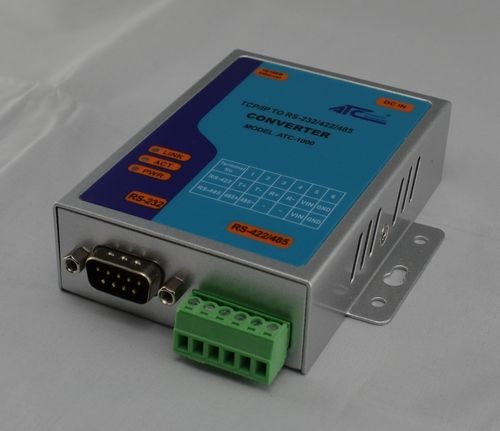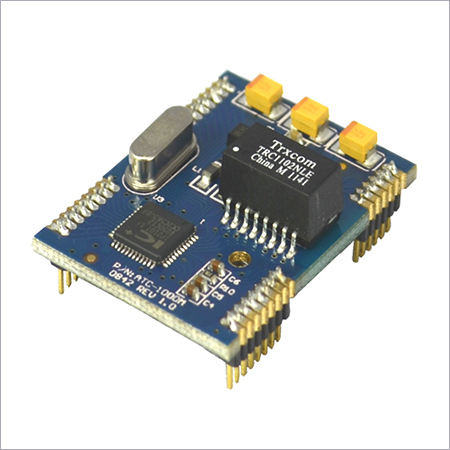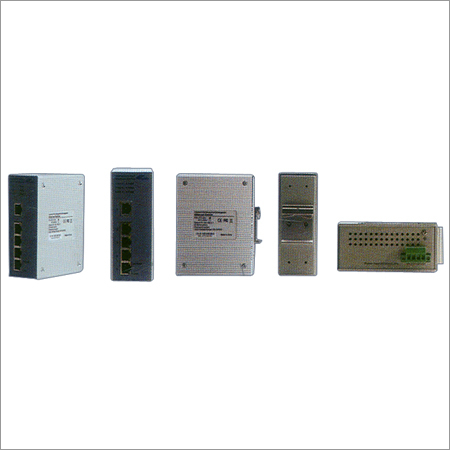
TCP/IP to 4-Port RS232/RS422/RS485 Converter
TCP/IP to 4-Port RS232/RS422/RS485 Converter Specification
- Product Type
- TCP/IP to Serial Converter
- Number of Channels
- 4
- Call Control Protocol
- TCP/IP, UDP, ARP, ICMP, HTTP, DHCP, SNMP, TFTP, Auto-negotiation
- Frequency (MHz)
- DC to 115200bps (Data Rate)
- Storage Temperature
- -40 to +85
- Network Connection Methods
- 10/100 Mbps Ethernet, RJ45
- Power
- 5V DC, 1A
- Dimension (L*W*H)
- 185mm x 110mm x 30mm
- Weight
- 600g
- Led Indicator
- Power, Link, Data, Status
- No. of Ports/Pins
- 4 Ports (RS232/RS422/RS485)
- Range
- Up to 100 meters (Ethernet)
- Material
- Metal
- Size
- Standard (185 x 110 x 30 mm)
- Usage
- Industrial Automation, Remote Device Control
- Power Supply
- 5V DC Adapter
- Color
- Black
- Height
- 30 mm
TCP/IP to 4-Port RS232/RS422/RS485 Converter Trade Information
- Minimum Order Quantity
- 1 , , Box
- Supply Ability
- , , Box
- Delivery Time
- 7 Days
About TCP/IP to 4-Port RS232/RS422/RS485 Converter
TCP/IP to 4-Port RS232/RS422/RS485 Converter : ATC-2004
Versatile Serial Connectivity
This converter allows users to select RS232, RS422, or RS485 protocols for each of its four serial ports, accommodating a wide range of industrial communication requirements. The flexible configuration streamlines integration with legacy and modern equipment alike, making it suitable for diverse automation or control applications.
Industrial-Grade Performance
Housed in a sturdy metal enclosure and supporting operation in extreme temperatures (-35 to +75) and high humidity (up to 95% RH non-condensing), the converter delivers reliable functioning even in harsh industrial environments. Protective features such as surge, over-voltage, and ESD safeguards further enhance the systems resilience.
Effortless Remote Management
Firmware upgrades can be performed online via Web or TFTP, simplifying maintenance and ensuring optimal performance. LED indicators (for power, link, data, and status) allow real-time monitoring, making troubleshooting and system checks straightforward for users and integrators.
FAQs of TCP/IP to 4-Port RS232/RS422/RS485 Converter:
Q: How do I switch between RS232, RS422, and RS485 serial modes on each port?
A: Each of the four serial ports on the converter is individually selectable for RS232, RS422, or RS485 operation. Mode selection is typically accomplished through dedicated hardware switches or configuration software provided with the device. Consult the user manual for detailed instructions on switching modes.Q: What is the process for upgrading the firmware on this converter?
A: Firmware upgrades are supported via Web browser interface or TFTP protocol. You can access the devices management page through its IP address, log in, and use the firmware update section for uploads. Alternatively, use TFTP for advanced network-based updates. Detailed instructions are provided in the user manual.Q: Where can this converter be installed and mounted?
A: The device is designed for flexibility in industrial environments. It can be mounted on a DIN rail or directly onto a wall, thanks to its robust mounting options. Its durable metal housing protects the converter from harsh conditions encountered in factories, automation panels, or remote sites.Q: What benefits does the 1500V RMS isolation protection provide?
A: The 1500V RMS isolation between the serial and Ethernet interfaces protects sensitive devices from voltage fluctuations, surges, and electrical noise. This significantly reduces the risk of equipment damage and data loss, ensuring stable and safe communication in electrically noisy or industrial settings.Q: What kind of devices or systems is this converter commonly used with?
A: This converter is widely used for industrial automation, remote device management, and connecting serial-based equipment to TCP/IP networks. Examples include programmable logic controllers (PLCs), sensors, meters, legacy control systems, and machinery that require secure, reliable communication over Ethernet.Q: When is it beneficial to use this multi-port converter instead of single-port models?
A: The 4-port design is especially beneficial when you need to integrate multiple serial devices at a single location with minimal wiring and network infrastructure. It streamlines installation by consolidating four connections into one network link, optimizing space, and reducing cost in industrial or commercial deployments.

Price:
- 50
- 100
- 200
- 250
- 500
- 1000+
More Products in Serial to TCP/IP(ETHERNET) Converter Category
ATC 1200 Serial To TCP/IP Ethernet Converter
Price 3800.00 INR / Piece
Minimum Order Quantity : 200
Product Type : Serial to Ethernet Converter
Weight : 120g
Number of Channels : 1
Dimension (L*W*H) : 96mm x 60mm x 22mm
ATC-1000M Serial To Ethernet Embedded Module
Price 1600.00 INR / Box
Minimum Order Quantity : 1 , , Box
Product Type : Serial To Ethernet Embedded Module
Weight : Approx. 22 g
Number of Channels : 1
Dimension (L*W*H) : 53 mm 30 mm 13 mm
RS232/RS422/RS485 to TCP/IP Converter
Price 16500.00 INR / Box
Minimum Order Quantity : 200
Product Type : Serial to Ethernet Converter
Weight : 280 g
Number of Channels : 1
Dimension (L*W*H) : 125 mm x 75 mm x 25 mm
5 Port Ethernet Switch
Price 12200 INR / Piece
Minimum Order Quantity : 1 Piece
Product Type : 5 PORT ETHERNET SWITCH
Weight : 0.8 kg (1.32lb) Kilograms (kg)
Dimension (L*W*H) : 54 x 105 x 135 mm (2.1 x 4.1 x 5.3 in) Millimeter (mm)
 |
MICON AUTOMATION SYSTEMS PVT. LTD.
All Rights Reserved.(Terms of Use) Developed and Managed by Infocom Network Private Limited. |

 English
English Spanish
Spanish French
French German
German Italian
Italian Chinese (Simplified)
Chinese (Simplified) Japanese
Japanese Korean
Korean Arabic
Arabic Portuguese
Portuguese Send Inquiry
Send Inquiry




